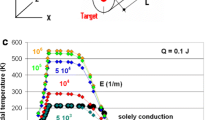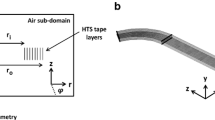Abstract
Currently, modelling hysteresis losses in superconductors is most often based on the H-formulation of the eddy current model (ECM) solved using the finite element method (FEM). In the H-formulation, the problem is expressed using the magnetic field intensity H and discretized using edge elements in the whole domain. Even though this approach is well established, it uses unnecessary degrees of freedom (DOFs) and introduces modelling error such as currents flowing in air regions due to finite air resistivity. In this paper, we present a modelling tool utilizing another H-oriented formulation of the ECM, making use of cohomology of the air regions. We constrain the net currents through the conductors by fixing the DOFs related to the so-called cohomology basis functions. As air regions will be truly non-conducting, DOFs and running times of these nonlinear simulations are reduced significantly as compared to the classical H-formulation. This fact is demonstrated through numerical simulations.







Similar content being viewed by others
Notes
External magnetic field is set by fixing H on the boundary of the modelling domain and net currents are forced using constraints based on integrals of current density over conducting surfaces.
This is, of course, also true for meshes consisting of, e.g., hexahedra, pyramids or prisms.
Superconducting composite wires are typically made of superconducting and normal conducting materials. Alternating magnetic fields induce heat generation in both superconducting and normal conducting parts of the wire. Such losses taking place in the wire have a common name: AC losses [2]. The modelling tool presented here is suitable for computing AC losses in general. However, we will only consider hysteresis losses in this paper, and we will use the terms AC loss and hysteresis loss somewhat interchangeably.
For an introduction to manifolds and differential geometry in the context of superconductor modelling, see [7]. We will be employing this language throughout the paper, as it is a very powerful and general way to present Maxwell’s theory and derived models.
The notation used in (1) is typical when forming quotient groups in algebra. For example, integers that are congruent modulo 2 through the typical congruence equivalence is often denoted as \(\mathbb {Z}/\mathbb {Z}_{2}\). There, you can add a multiple of 2 to any number, and it will belong to the same congruence class. In this case, we have, in a similar sense, an equivalence of cycles modulo boundaries. [20]
A differential form χ is closed, provided that dχ = 0.
A differential form η is exact, provided that it can be expressed as an exterior derivative of another form: \(\eta = \mathrm {d} \hat {\chi }\). An exact form is an instance of a coboundary.
Gmsh is an open-source finite element mesh generator with pre- and post-processing facilities: http://geuz.org/gmsh/
SUNDIALS IDA is a generic adaptive time-stepping solver for stiff differential-algebraic equation systems. It is based on variable order backwards differentiation formulas combined with a robust error estimator. At each time-step, a Newton iteration is used to solve a nonlinear algebraic equation system, utilizing a preconditioned Krylov subspace method [23]. The underlying numerical method is often referred to as DASPK or DASSL [24].
Formally, we are seeking a solution for H in the space of such piecewise smooth square integrable 1-forms on Ω that fulfill boundary conditions (13)–(16) and the constraints in (11), and for which constraint (12) holds on Ωnc. Furthermore, the weak exterior derivatives of the 1-forms need to be square integrable. For the formal definition of the correct Sobolev spaces of differential forms for FEM, see [30].
More precisely, V T(Ωnc) is the chosen set of basis vectors of H 1(Ωnc), which we use to identify the tunnels through Ωnc.
However, we keep those DOFs φ i that lie exactly on the interface.
The simulations were performed on the author’s laptop computer utilizing a single processor core.
References
Bruzzone, P.: Physica C 401, 7 (2004)
Grilli, F., Pardo, E., Stenvall, A., Nguyen, D.N., Yuan, W., Gömöry F.: IEEE Trans. Appl. Supercond. 24, 8200433 (2014)
Lahtinen, V., Stenvall, A.: J. Supercond. Nov. Magn. 27(2014), 641 (2014)
Brambilla, R., Grilli, F., Martini, L.: Supercond. Sci. Techol. 20, 16 (2007)
Grilli, F., Brambilla, R., Sirois, F., Stenvall, A., Memiaghe, S.: Cryogenics 53, 142 (2013)
Hong, Z., Campbell, A.M., Coombs, T.A.: Supercond. Sci. Techol. 19, 1246 (2006)
Lahtinen, V., Lyly, M., Stenvall, A., Tarhasaari, T.: Supercond. Sci. Technol. 25, 115001 (2012)
Zhang, M., Coombs, T.A.: Supercond. Sci. Techol. 25, 015009 (2012)
Comsol Multiphysics is a commercial FEM program. http://www.comsol.com
Bossavit, A.: IEEE Proc. 135, 493 (1988)
Bíró, O.: Comput. Method Appl. M. 169, 391 (1999)
Frankel, T.: The geometry of physics: An introduction third edition Cambridge. Cambridge University Press, UK (2012)
Kotiuga, P.R.: J. Appl. Phys. 61, 3916 (1987)
Henrotte, F., Hameyer, K.: IEEE Trans. Magn. 39(2003), 1167 (2003)
Kettunen, L., Forsman, K., Bossavit, A.: Int. J. Numer. Meth. Eng. 41, 935 (1998)
Pellikka, M., Suuriniemi, S., Kettunen, L., Geuzaine, C.: SIAM J. Sci. Comput. 35, B1195 (2013)
Stenvall, A., Lahtinen, V., Lyly, M.: Supercond. Sci. Technol. 27, 104004 (2014)
Gross, P.W., Kotiuga, P.R.: Electromagnetic Theory and Computation: A Topological Approach. Cambridge University Press, New York (2004)
Nash, C., Sen, S.: Topology and Geometry for Physicists. Academic Press, Orlando (1987)
Foldes, S.: Fundamental Structures of Algebra and Discrete Mathematics. Wiley-Interscience, USA (1994)
Pellikka, M., Tarhasaari, T., Suuriniemi, S., Kettunen, L.: J. Comp. Appl. Math 246, 225
Geuzaine, C., Remacle, J.F.: Int. J. Numer. Meth. Eng. 79, 1309 (2009)
Hindmarsh, A.C., Brown, P.N., Grant, K.E., Lee, S.L., Serban, R., Shumaker, D.E., Woodward, C.S.: ACM T. Math. Software 31, 363 (2005). SUNDIALS software package is available online at: https://computation.llnl.gov/casc/sundials/
Brenan, K.E., Campbell, S.L., Petzold, L.R.: Numerical solution of initial-value problems in differential-algebraic equations. SIAM, Philadelphia, PA (1996)
Ghosh, A.K.: Physica C. 401, 15 (2004)
Motaman, A., et al.: J. Supercond. Nov. Magn. 27, 1643 (2014)
Pardo, E., Šouc, J., Kovač, J.: Supercond. Sci. Technol. 25, 035–003 (2012)
Norris, W.T.: J. Phys. D: Appl. Phys. 3, 489 (1967)
Lyly, M., Lahtinen, V., Stenvall, A., Tarhasaari, T., Mikkonen, R.: Approaches for tree - co-tree gauged T−φ formulated eddy current problem in superconductor hysteresis loss simulations. IEEE Trans. Appl. Supercond. 23 (8200909) (2013)
Kurz, S., Auchmann, B.: Fast Boundary Element Methods in Engineering and Industrial Applications: Lecture notes in Applied and Computational Mechanics, vol. 63, pp 1–62 (2012)
Kettunen, L., Forsman, K., Bossavit, A.: IEEE Trans. Magn. 34(1998), 2551 (1998)
Stenvall, A., Tarhasaari, T.: Supercond. Sci. Technol. 23, 075010 (2013)
Acknowledgments
This research was partially supported by The Academy of Finland project #250652. Most of the work leading to this research was conducted during the research exchange period of Valtteri Lahtinen 19.8.2013–15.2.2014 at École Polytechnique de Montréal, Montréal, Canada.
Author information
Authors and Affiliations
Corresponding author
Rights and permissions
About this article
Cite this article
Lahtinen, V., Stenvall, A., Sirois, F. et al. A Finite Element Simulation Tool for Predicting Hysteresis Losses in Superconductors Using an H-Oriented Formulation with Cohomology Basis Functions. J Supercond Nov Magn 28, 2345–2354 (2015). https://doi.org/10.1007/s10948-015-3074-x
Received:
Accepted:
Published:
Issue Date:
DOI: https://doi.org/10.1007/s10948-015-3074-x




